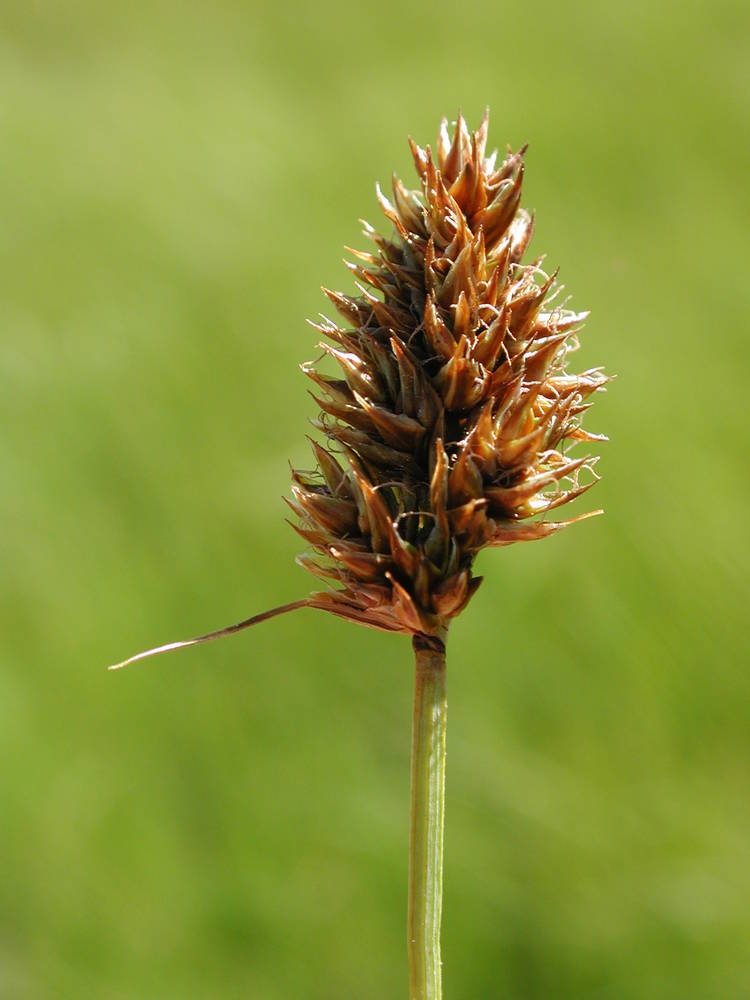
Plants more or less dioecious, rhizomatous, forming large, dense stands; rhizomes pale to brown, 1.5–2.8 mm in diameter; culms (10)20–50(100) cm tall; plant bases brownish.
Leaves blades 1–3.7 mm wide.
Inflorescences 1–3 cm long, male inflorescences (3)3.8–6.5(9) mm wide, female inflorescences (4)5–14 mm wide; inflorescences in one plant seemingly all female or all male but usually with a few, nearly undetectable flowers of the opposite sex mixed in the spikes.
Female scales reddish brown with hyaline margins.
Anthers with a tiny smooth to warty awn.
Perigynia 1.8–2.8 × 1.1–1.7 mm, dark brown, glossy; beak 0.25–0.5 mm long; stigmas 2.
Achenes lenticular.
Wet meadows and springs, on stable stream terraces that are not scoured, where the water table is at or above the soil surface until late summer, generally on calcareous or slightly alkaline substrates; in and east of the Cascades. 700–2500 m. BR, BW, Casc, ECas, Lava, Owy. CA, ID, WA; northeast to Alberta, east to CO, southeast to NM. Native.
Carex simulata has short, dark, plump perigynia. Male plants can be identified based on the narrow leaves, rhizomatous habit, dull plant bases, clonal habit, and wet habitat. Carex praegracilis and C. douglasii grow in drier habitats and have longer perigynium beaks. Carex praegracilis has blackish rhizomes.
as described under Carex simulata
Rhizomes coarse, 1.5-2.8 mm thick, typically with long, unbranched segments from which shoots arise singly every few nodes. Culms sharply trigonous, (10-)20-80 cm, scabrous-angled distally. Leaves: basal sheaths dark brown; sheaths with hyaline inner band, apex prolonged 0.3-1.6 mm beyond base of blade, glabrous; ligules 0.6-2.7 mm; blades 1-3.7 mm wide. Inflorescences dense to elongate, 1-3 cm; spikes 4-12(-18), usually unisexual; staminate spikes lanceoloid; pistillate spikes ovoid. Pistillate scales reddish brown to dark brown, with narrow hyaline margins, ovate, apex acute to acuminate-awned, shiny. Anthers 1.8-3.1 mm, apiculus smooth to warty (30X). Perigynia dark reddish brown, essentially veinless, stipitate, broadly ovate to rhombic-orbicular, thickly plano-convex, 1.8-2.8 × 1.1-1.7 mm, shiny; beak 0.25-0.5 mm, hyaline, oblique or obscurely bidentulate.Fruiting Jun-Aug. Wet meadows, marshes, seeps, fens, bogs, stream banks, lakeshores, ditches, tolerant of alkaline soils; 600-3100 m; Alta., Sask.; Ariz., Calif., Colo., Idaho, Mont., N.Mex., Oreg., Utah, Wash., Wyo.